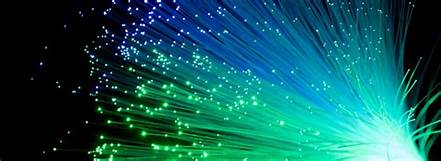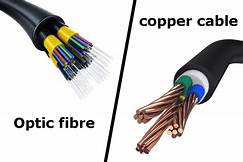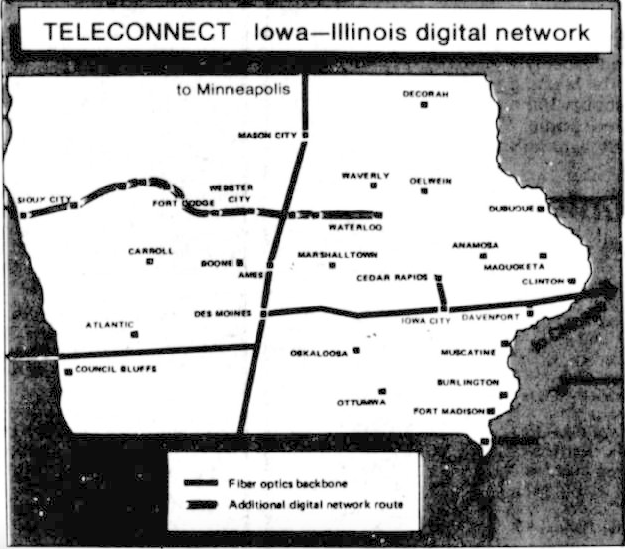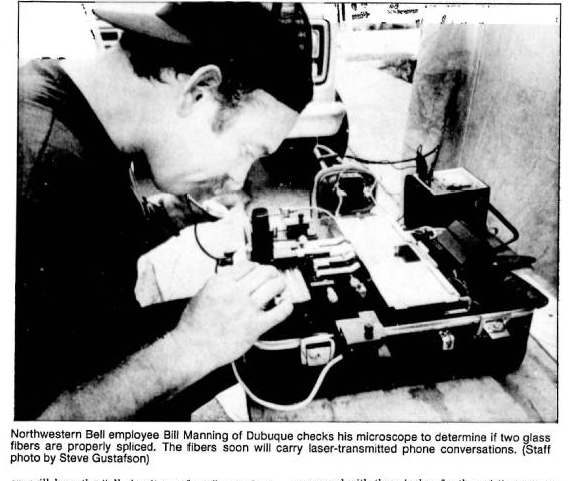Encyclopedia Dubuque
"Encyclopedia Dubuque is the online authority for all things Dubuque, written by the people who know the city best.”
Marshall Cohen—researcher and producer, CNN
Affiliated with the Local History Network of the State Historical Society of Iowa, and the Iowa Museum Association.
FIBER OPTICS
FIBER OPTICS. Fiber optics (optical fibers) are long, thin strands of very pure glass about the diameter of a human hair. They are arranged in bundles called optical cables and used to transmit light signals over long distances. A single optical fiber has the following parts:
Core - Thin glass center of the fiber where the light travels
Cladding - Outer optical material surrounding the core that reflects
the light back into the core
Buffer coating - Plastic coating that protects the fiber from damage
and moisture
Hundreds or thousands of these optical fibers are arranged in bundles in optical cables. The bundles are protected by the cable's outer covering, called a jacket. Optical fibers come in two types: Single-mode fibers and multi-mode fibers. Single-mode fibers have small cores (about 3.5 x 10-4 inches or 9 microns in diameter) and transmit infrared laser light (wavelength = 1,300 to 1,550 nanometers). Multi-mode fibers have larger cores (about 2.5 x 10-3 inches or 62.5 microns in diameter) and transmit infrared light (wavelength = 850 to 1,300 nm) from light-emitting diodes (LEDs).
Some optical fibers can be made from plastic. These fibers have a large core (0.04 inches or 1 mm diameter) and transmit visible red light (wavelength = 650 nm) from LEDs.
The light in a fiber-optic cable travels through the core by constantly bouncing from the cladding (mirror-lined walls), a principle called total internal reflection. Because the cladding does not absorb any light from the core, the light wave can travel great distances. However, some of the light signal degrades within the fiber, mostly due to impurities in the glass. The extent that the signal degrades depends on the purity of the glass and the wavelength of the transmitted light (for example, 850 nm = 60 to 75 percent/km; 1,300 nm = 50 to 60 percent/km; 1,550 nm is greater than 50 percent/km). Some premium optical fibers show much less signal degradation -- less than 10 percent/km at 1,550 nm.
Understanding how messages are transmitted can be compared with two naval ships in a fleet needing to communicate with each other. The captain of one ship sends a message to a sailor on deck. The sailor translates the message into Morse code (dots and dashes) and uses a signal light (floodlight with a venetian blind type shutter on it) to send the message to the other ship. A sailor on the deck of the other ship sees the Morse code message, decodes it into English, and sends the message up to the captain.
A fiber-optic relay system consists of the following:
Transmitter - Produces and encodes the light signals Optical fiber - Conducts the light signals over a distance Optical regenerator - May be necessary to boost the light signal (for long distances) Optical receiver - Receives and decodes the light signals
The transmitter is like the sailor on the deck of the sending ship. It receives and directs the optical device to turn the light "on" and "off" in the correct sequence, thereby generating a light signal. The transmitter is physically close to the optical fiber and may even have a lens to focus the light into the fiber. Lasers have more power than LEDs, but vary more with changes in temperature and are more expensive. The most common wavelengths of light signals are 850 nm, 1,300 nm, and 1,550 nm (infrared, non-visible portions of the spectrum).
As mentioned before, some signal loss occurs when the light is transmitted through the fiber, especially over long distances (more than a half mile, or about 1 km). One or more optical regenerators is spliced along the cable to boost the degraded light signals.
An optical regenerator consists of optical fibers with a special coating (doping). The doped portion is "pumped" with a laser. When the degraded signal comes into the doped coating, the energy from the laser allows the doped molecules to become lasers themselves. The doped molecules then emit a new, stronger light signal with the same characteristics as the incoming weak light signal. The regenerator is a laser amplifier for the incoming signal.
The optical receiver is like the sailor on the deck of the receiving ship. It takes the incoming digital light signals, decodes them and sends the electrical signal to the other user's computer, TV or telephone (receiving ship's captain). The receiver uses a photocell or photodiode to detect the light.
Fiber-optic systems are revolutionizing telecommunications. Several miles of optical cable can be made cheaper than equivalent lengths of copper wire. Optical fibers can be drawn to smaller diameters than copper wire. Because optical fibers are thinner than copper wires, more fibers can be bundled into a given-diameter cable than copper wires. This allows more phone lines to go over the same cable or more channels to come through the cable into your cable TV box. The loss of signal in optical fiber is less than in copper wire. Unlike electrical signals in copper wires, light signals from one fiber do not interfere with those of other fibers in the same cable. This means clearer phone conversations or TV reception. Because signals in optical fibers degrade less, lower-power transmitters can be used instead of the high-voltage electrical transmitters needed for copper wires. Optical fibers are ideally suited for carrying digital information, which is especially useful in computer networks. Because no electricity is passed through optical fibers, there is no fire hazard. An optical cable weighs less than a comparable copper wire cable. Fiber-optic cables take up less space in the ground. Because fiber optics are so flexible and can transmit and receive light, they are used in many flexible digital cameras for the following purposes:
Medical imaging - in bronchoscopes, endoscopes, laparoscopes Mechanical imaging - inspecting mechanical welds in pipes and engines (in airplanes, rockets, space shuttles, cars) Plumbing - to inspect sewer lines
Fiber optics offer promise in many industries, most notably telecommunications and computer networks. A telephone call to Europe from the United States is bounced off a communications satellite with the result that an echo is often heard on the line. With transatlantic fiber-optic cables there is a direct connection with no echoes. (1)
Having missed the opportunity to be on an interstate highway, Dubuque's business leaders in 1986 had no intention of being overlooked for fiber optics. Teleconnect had recently skipped Dubuque leaving the community without a link. The largest fiber optics network being constructed by Williams Telecommunication Company and marketed by Teleconnect ran east-west from Davenport through Des Moines and into Omaha It also ran from Des Moines north toward Minneapolis and south toward Kansas City. Teleconnect announced plans for its own line from Waterloo to Sioux City. Recognizing fiber optics were essential to development of the city, the GREATER DUBUQUE DEVELOPMENT CORPORATION formed a task force to attract at least one digital communication operation to Dubuque. In its attempt to lure Greyhound Corporation's telephone information to Dubuque, however, Dubuque officials were told Greyhound could not consider the city due to its lack of high-volume and competitive telecommunication service. CYCARE SYSTEMS, INC., a current Dubuque business, was concerned by the limitations of current long distance service. The only long distance carrier, American Telephone and Telegraph (AT&T), carried telephone and computer data but was obsolete in terms of digital transmission. Digital transmission compared to traditional analog transmission, eliminated background noise and mistakes from computer data. Digital transmission allowed quicker communication and could accommodate picture phones and teleconferencing. (2)
AT&T suggested it could provide satellite and microwave services capable of handling digital telecommunications. A consultant suggested local industries might have to become partners with firms that could supply fiber optic or digital lines. (3) Disappointing news came later in 1986 when Teleconnect announced it was not going to extend its fiber optic line from Waterloo to Dubuque. (4)
Where there had been an absence of digital communication, 1987 began the new year with Teleconnect Co. of Cedar Rapids and NorLightight of Madison, Wisconsin expressing interest in installing fiber optics in Dubuque. On July 21, 1987 work began by Northwestern Bell on installing Dubuque's first fiber optic telephone lines. (5)
The installation was intricate. The glass filaments, said to look like brightly colored fishline, were dipped in acetone to remove impurities and then cut with a microscopic-precision cutter. The cut made to splice two pieces of filament together had to be clean with no rounded edges. As filaments were spliced, technicians in the Northwestern Bell office downtown viewed their computer to see the circuit was clear. While claims that a person could hear a pin drop at the other end of a call were true, the principal advantage was the increased capacity. The announcement that "all circuits are busy" would be heard less often and the increasing load of computer-to-computer telephone communication could be handled. Completed fiber optic cables would be one-half inch in diameter compared to three inches for copper cables. (6)
Dubuque's first fiber optics began operations at 1:00 a.m. on January 31, 1989. The fiber optics facility was located on the top floor of CYCARE PLAZA. The Teleconnect fiber line to Cedar Raids had five pairs of fiber optics cable capable of handling 30,000 simultaneous telephone calls. At the time, officials said the most calls going out of Dubuque at one time was 200. The facility converyed an electromagnetic signal from a conventional telephone into a laser beam. Producing the light source were semiconductors so larger than a grain of salt. The laser beams were then transmitted through the fibers to Cedar Rapids where the pelephone calls were stitched. The error rate for fiber optics was "one bit in a billion." the comparable rate of error in 100 telephone calls running around the clock for two years--losing only one syllable. Teleconnect exployed nineteen people in its Dubuque long-distance, phone systems, and directory offices. (7)
The Iowa Communications Network, a $114 million fiber optics system, in 1994 allowed hospitals, medical centers, and clinics in each of Iowa's 99 counties to communicate. Consultations between doctors, transfer of medical records, images, and other information immediately reduced patient travel, avoided duplicate exams and procedures and reduced costs. (8)
In 1995 Dubuque was the largest city in Iowa not connected to the state's fiber optics communications network. The nearest connections to the systems were in Peosta and Maquoketa. In an agreement TCI Cablevision of Dubuque, the company would bring the Iowa Communications Network to nineteen Dubuque schools, hospitals, colleges and government agencies by June 30, 1996. TCI's estimated cost to upgrade its system and make the connections was estimated at $3 million. In exchange TCI was granted some waivers in its franchise agreement with the city. The city also agreed to construct a $24,000 building for state fiber optics network equipment. City, county, schools and hospitals would have to pay for the equipment to hold interactive conferences or classes. The city expected the cost for one equipped conference room at $50,000. Installations to the ARMORY was expected within thirty days. The three local colleges were authorized for connection under Phase III of the statewide construction plan. (9)
The Dubuque City Council in 2010 announced it would use a $500,000 grant from the Iowa Office of Energy Independence to fund half the cost of upgrading traffic signals from the NORTHWEST ARTERIAL to Ninth Street. New signals with fiber optic technology would allow the control of traffic. Fiber optic technology had already been replacing 1970s-era signals in other locations. Drivers were expected to save an estimated 207,247 gallons of fuel annually or about $526,000 not idling at stoplights. In 2008 during heavy flooding, the state directed traffic through Dubuque when I-80 was closed. Adjusting the lights along Dodge allowed traffic to move smoothly.
---
Sources:
1. Freudenrich, Craig, "How Fiber Optics Work," Howstuffworks. Online: https://computer.howstuffworks.com/fiber-optic.htm
2. Kirchen, Rich, "Leaders Seek Fiber Optics," Telegraph Herald, June 8, 1986, p. 1
3. Ibid.
4. Kirchen, Rich, "Still Looking to Connect," Telegraph Herald, November 12, 1986, p. 3
5. Chanaud, Timothy, "Second Firm May Bring Fiber Optics," Telegraph Herald, January 1, 1987, p. 3
6. Hanson, Lyn, "Plain as Day: Fiber Optics Arrive," Telegraph Herald, July 23, 1987, p. 1
7. Pritchard, Ken, "Fiber Optic Link Takes Dubuque a Step Forward," Telegraph Herald, March 19, 1989, p. 11
8. "@ TVs Talking," Telegraph Herald, July 15, 1994, p. 26, p. 26
8. Webber, Steve, "City to Link Up With Fiber Optics," Telegraph Herald, April 8, 1995, p. 3





